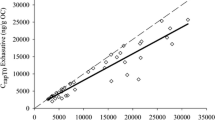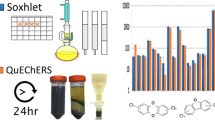Abstract
Background, Aims and Scope
Effect-directed analysis (EDA) is a powerful tool for the identification of key toxicants in complex environmental samples. In most cases, EDA is based on total extraction of organic contaminants, which may lead to an erroneous prioritisation with regard to hazard and risk. Bioaccessibility-directed extraction aims to discriminate between contaminants that take part in partitioning between sediment and biota in a relevant time frame and those that are enclosed in structures that do not allow rapid desorption. Standard protocols of targeted extraction of the rapidly desorbing, and thus bioaccessible, fraction using TENAX® are based only on small amounts of sediment. In order to obtain sufficient extract for subsequent biotesting, fractionation and structure elucidation, a large volume extraction technique needs to be developed applying one selected extraction time and excluding toxic procedural blanks.
Methods
Desorption behaviour of sediment contaminants was determined by combining consecutive extraction of sediment using TENAX® with a three-compartment desorption model. Time needed to remove the rapidly desorbing fraction, trap, was calculated to select a fixed extraction time for single extraction procedures. Up-scaling by about a factor of 125 provided a large volume extraction technique for EDA. Reproducibility and comparability to the small volume approach were analysed. TENAX® blanks and sediment extracts were tested for toxicity using Scenedesmus vacuolatus and Artemia salina as test organisms.
Results and Discussion
Desorption kinetics showed that 12 to 30% of sediment-associated pollutants were available for rapid desorption, while 70 to 90% of PAHs found in the sediment belong to the slowly and very slowly desorbing pool with very limited bioavailability. trap is compound dependent and covers a range of 2 to 18 h. A fixed extraction time of 24 h was selected as a time at which even the rapidly desorbing fraction of big hydrophobic compounds should be fully desorbed. High reproducibility of the large volume approach and good agreement with the small consecutive approach were found. Significant toxicity of procedural TENAX® blanks was found with Scenedesmus vacuolatus, which is in agreement with chemical analysis and could be reduced by pre-cleaning of TENAX® with Accelerated Solvent Extraction (ASE). Toxicity of blanks prior to ASE-clean up was about three orders of magnitude below the toxicity of sediment extracts.
Conclusions
For consideration of bioaccessibility in EDA, a large volume TENAX® extraction method was presented. Although several other solid phases can be used to extract the bioaccessible fraction, TENAX® has unique properties for depletive extraction of the rapidly desorbing fraction from large amounts of sediment. Toxicity and chemical blanks due to production residues are shortcomings of the method that can be overcome by accurate pre-cleaning, e.g. with ASE.
Recommendations and Perspectives
Higher purity of TENAX® guaranteed by the manufacturers would significantly enhance the applicability of the method. Using TENAX® instead of total extraction may improve key toxicant prioritisation by considering exposure and effect rather than effect only.
Similar content being viewed by others
References
Altenburger R, Walter H, Grote M (2004): What contributes to the combined effect of a complex mixture? Environ Sci Technol 38(23) 6353–6362
Biselli S, Reineke N, Heinzel N, Kammann U, Franke S, Hühnerfuss H, Theobald N (2005): Bioassay-directed fractionation of organic extracts of marine surface sediments from the North and Baltic Sea. Part I: Determination and identification of organic pollutants. J Soils Sediments 5, 171–181
Booth LH, Heppelthwaite VJ, O’Halloran K (2005): Effects-based assays in the earthworm Aporrectodea caliginosa — Their utilisation for evaluation of contaminated sites before and after remediation. J Soils Sediments 5(2) 87–94
Brack W (2003): Effect-directed analysis: a promising tool for the identification of organic toxicants in complex mixtures. Anal Bioanal Chem 377, 397–407
Brack W, Altenburger R, Ensenbach U, Möder M, Segner H, Schüürmann G (1999): Bioassay-directed identification of organic toxicants in river sediment in the industrial region of Bitterfeld (Germany) — A contribution to hazard assessment. Arch Environ Contam Toxicol 37, 164–174
Brack W, Klamer HJC, López de Alda MJ, Barceló D (2007): Effect-directed analysis of key toxicants in European river basins. A review. Env Sci Pollut Res 14(1) 30–38
Brack W, Bakker J, de Deckere E, Deerenberg C, van Gils J, Hein M, Jurajda P, Kooijman B, Lamoree M, Lek S, Lopez de Alda MJ, Marcomini A, Munoz I, Rattei S, Segner H, Thomas K, von der Ohe PC, Westrich B, de Zwart D, Schmitt-Jansen M (2005): MODELKEY. Models for assessing and forecasting the impact of environmental key pollutants on freshwater and marine ecosystems and biodiversity. Env Sci Pollut Res 12, 252–256
Brack W, Schirmer K (2003): Effect-directed identification of oxygen and sulphur heterocycles as major polycyclic aromatic cytochrome P4501A-inducers in a contaminated sediment. Environ Sci Technol 37, 3062–3070
Brack W, Schirmer K, Erdinger L, Hollert H (2005): Effect-directed analysis of mutagens and ethoxyresorufin-O-deethylase inducers in aquatic sediments. Environ Toxicol Chem 24, 2445–2458
Cornelissen G, Gustafsson O, Bucheli TD, Jonker MTO, Koelmans AA, van Noort PCM (2005): Extensive sorption of organic compounds to black carbon, coal, and kerogen in sediments and soils: Mechanisms and consequences for distribution, bioaccumulation, and biodegradation. Environ Sci Technol 39(18) 6881–6895
Cornelissen G, Rigterink H, Ferdinandy MMA, van Noort PCM (1998): Rapidly desorbing fractions of PAHs in contaminated sediments as a predictor of the extent of bioremediation. Environ Sci Technol 32, 966–970
Cornelissen G, Rigterink H, ten Hulscher DEM, Vrind BA, van Noort PCM (2001): A simple Tenax extraction method to determine the availability of sediment-sorbed organic compounds. Environ Toxicol Chem 20, 706–711
Cornelissen G, Rigterink H, Vrind BA, tenHulscher TEM, Ferdinandy MMA, vanNoort PCM (1997a): Two-stage desorption kinetics and in situ partitioning of hexachlorobenzene and dichlorobenzenes in a contaminated sediment. Chemosphere 35(10) 2405–2416
Cornelissen G, van Noort PCM, Govers HAJ (1997b): Desorption kinetics of chlorobenzenes, polycyclic aromatic hydrocarbons, and polychlorinated biphenyls: Sediment extraction with TENAX and effects of contact time and solute hydrophobicity. Environ Toxicol Chem 16, 1351–1357
Cornelissen G, vanNoort PCM, Parsons JR, Govers HAJ (1997c): Temperature dependence of slow adsorption and desorption kinetics of organic compounds in sediments. Environ Sci Technol 31(2) 454–460
Cuypers C, Pancras T, Grotenhuis T, Rulkens W (2002): The estimation of PAH bioavailability in contaminated sediments using hydroxypropyl-beta-cyclodextrin and Triton X-100 extraction techniques. Chemosphere 46(8): 1235–1245
Greenberg MS, Burton GA, Landrum PF, Leppanen MT, Kukkonen JVK (2005): Desorption kinetics of fluoranthene and trifluralin from Lake Huron and Lake Erie, USA, sediments. Environ Toxicol Chem 24(1) 31–39
Heise J, Heimbach U, Schrader S (2005): Influence of soil organic carbon on acute and chronic toxicity of plant protection products to Poecilus cupreus (Coleoptera, Carabidae) larvae. J Soils Sediments 5(3) 139–142
Kammann U, Biselli S, Reineke N, Wosniok W, Danischewski D, Hühnerfuss H, Kinder A, Sierts-Herrmann A, Theobald N, Vahl HH, Vobach M, Westendorf J, Steinhart H (2005): Bioassay-directed fractionation of organic extracts of marine surface sediments from the North and Baltic Sea. Part II: Results of the biotest battery and development of a biotic index. J Soils Sediments 5(4) 225–232
Kukkonen JVK, Landrum PF, Mitra S, Cossiaux DC, Gunnarsson J, Weston D (2004): The role of desorption for describing the bioavailability of select polycyclic aromatic hydrocarbon and polychlorinated biphenyl congeners for seven laboratory-spiked sediments. Environ Toxicol Chem 23, 1842–1851
Kukkonen JVK, Landrum PF, Mitra S, Gossiaux DC, Gunnarsson J, Weston D (2003): Sediment characteristics affecting desorption kinetics of select PAH and PCB congeners for seven laboratory spiked sediments. Environ Sci Technol 37(20) 4656–4663
Lamoureux EM, Brownawell BJ (1999): chemical and biological availability of sediment-sorbed hydrophobic organic contaminants. Environ Toxicol Chem 18(8) 1733–1741
Leppänen MT, Kukkonen JVK (2006): Evaluating the role of desorption in bioavailability of sediment-associated contaminants using oligochaetes, semipermeable membrane devices and Tenax extraction. Environ Pollut 140(1) 150–163
Leppänen MT, Landrum PF, Kukkonen JVK, Greenberg MS, Burton GA, Robinson SD, Gossiaux DC (2003): Investigating the role of desorption on the bioavailability of sediment-associated TCBP in benthic invertebrates. Environ Toxicol Chem 22(12) 2861–2871
Macrae J, Hall K (1998): Comparison of methods used to determine the availability of polycyclic aromatic hydrocarbons in marine sediment. Environ Sci Technol 32(23) 3809–3815
Nilsson T, Bowadt S, Bjorklund E (2002): Development of a simple selective SFE method for the determination of desorption behaviour of PCBs in two Swedish sediments. Chemosphere 46(3) 469–476
Oen AMP, Breedveld GD, Kalaitzidid S, Christianis K, Cornelissen G (2006a): How quality and quantity of organic matter affect polycyclic aromatic hydrocarbon desorption from Norwegian harbor sediments. Environ Toxicol Chem 25, 1258–1267
Oen AMP, Schaanning M, Ruus A, Cornelissen G, Kallqvist T, Breedveld GD (2006b): Predicting low biota to sediment accumulation factors of PAHs by using infinite-sink and equilibrium extraction methods as well as BC-inclusive modeling. Chemosphere 64(8) 1412–1420
Olsman H, Schnürer A, Björnfoth H, van Bavel B, Engwall M (2007): Fractionation and Determination of Ah Receptor (AhR) Agonists in Organic Waste After Anaerobic Biodegradation and in Batch Experiments with PCB and decaBDE. Env Sci Pollut Res 14(Special Issue 1) 36–43
Pignatello JJ, Xing B (1996): Mechanisms of slow sorption of organic chemicals to natural particles. Environ Sci Technol 30, 1–11
Ramos EU, Meijer SN, Vaes WHJ, Verhaar HJM, Hermens JLM (1998): Using Solid-Phase Microextraction to Determine Partition Coefficients to Humic Acids and Biovailable Concentration of Hydrophobic Chemicals. Environ Sci Technol 32, 3430–3435
Reichenberg F, Mayer P (2006): Two complementary sides of bioavailability: Accessibility and chemical activity of organic contaminants in sediments and soils. Environ Toxicol Chem 25, 1239–1245
Reid BJ, Stokes JD, Jones KC, Semple KT (2000): Nonexhaustive cyclodextrin-based extraction technique for the evaluation of PAH bioavailability. Environ Sci Technol 34, 3174–3179
Seiler TB, Rastall AC, Leist E, Erdinger L, Braunbeck T, Hollert H (2006): Membrane dialysis extraction (MDE): A novel approach for extracting toxicologically relevant hydrophobic organic compounds from soils and sediments for assessment in biotests. J Soils Sediments 6(1) 20–29
ten Hulscher DEM, Postma J, den Besten PJ, Stroomberg GJ, Belfroid A, Wegener JW, Faber JH, van der Pol JJC, Hendriks AJ, van Noort PCM (2003): Tenax extraction mimics benthic and terrestrial bioavailability of organic compounds. Environ Toxicol Chem 22(10) 2258–2265
ten Hulscher TEM, van Noort PCM, van der Velde LE (1997a): Equilibrium partitioning theory overestimates chlorobenzene concentrations in sediment porewater from Lake Ketelmeer, the Netherlands. Chemosphere 35(10) 2331–2344
ten Hulscher TEM, van Noort PCM, van der Velde LE (1997b): Equilibrium partitioning theory overestimates chlorobenzene concentrations in sediment porewater from lake Ketelmeer, the Netherlands. Chemosphere 35(10) 2331–2344
Thorsen WA, Cope WG, Shea D (2004): Bioavailability of PAHs: Effects of soot carbon and PAH source. Environ Sci Technol 38, 2029–2037
Vanhaecke P, Persoone G, Claus C, Sorgeloos P (1981): Proposal for A Short-Term Toxicity Test with Artemia-Nauplii. Ecotox Environ Saf 5(3) 382–387
White JC, Hunter M, Nam KP, Pignatello JJ, Alexander M (1999): Correlation between biological and physical availabilities of phenanthrene in soils and soil humin in aging experiments. Environ Toxicol Chem 18(8) 1720–1727
You J, Landrum PF, Lydy MJ (2006): Comparison of chemical approaches for assessing bioavailability of sediment-associated contaminants. Environ Sci Technol 40(20) 6348–6353
Zhao DY, Pignatello JJ (2004): Model-aided characterization of Tenax (R)-TA for aromatic compound uptake from water. Environ Toxicol Chem 23(7) 1592–1599
Author information
Authors and Affiliations
Corresponding author
Additional information
ESS-Submission Editor: Dr. Henner Hollert (Henner.Hollert@urz.uni-heidelberg.de)
This paper has been developed on the basis of a presentation given at the 11th Annual Meeting of SETAC-GLB held 2006 in Landau.
Rights and permissions
About this article
Cite this article
Schwab, K., Brack, W. Large volume TENAX® extraction of the bioaccessible fraction of sediment-associated organic compounds for a subsequent effect-directed analysis. J Soils Sediments 7, 178–186 (2007). https://doi.org/10.1065/jss2007.03.393
Received:
Accepted:
Published:
Issue Date:
DOI: https://doi.org/10.1065/jss2007.03.393




